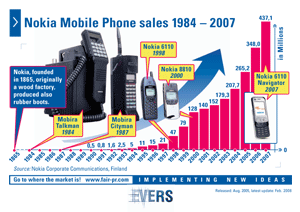Arno's EnergyIdeas (7)
Boycott calls and the power of the market ...
Currently, German politicians call the consumer to boycott mobile phones from a specific manufacturer (Nokia). Not so long ago, almost the same politicians appealed to the customer to buy certain mobile phones of another manufacturer (BenQ Mobile). How useful are such appeals?
In January 2007, BenQ Mobile, which branched out of Siemens mobile, closed their plant in Kamp-Lintfort, Germany. Nokia's plant in Bochum, Germany, with around 2,300 employees, has announced the expected closure to be "mid-2008" . Negotiations are going on. Is Nokia to be blamed correctly?
Nokia Corporation, based in Espoo, Finland, has sold more than 437 million mobile phones in 2007 (348 million in 2006). They have 15 manufacturing plants in nine countries and they distribute their products in 150 countries.

With over 437 million mobile phones sold in 2007, Nokia is now worldwide market leader. |
How has Nokia reached this leadership position? My analysis: Only with farsighted shareholders, good management, excellent employees (about 112.000 from over 120 nations), clever manufacturing, quality assurance, logistics, marketing and a strong distribution system can a company motivate millions of customers from around the globe to buy their products at such remarkable rates. Alone in 2007, Nokia produced and sold in average 1.119.534 mobile phones per day. In the third quarter of 2007, the company reached a turnover of 12.9 billion Euro (approx. 19 billion US Dollars). Per day, the turnover was 143 million Euros (approx. 207 million US Dollars). Then net profit created was 1.56 Billion Euro (approx. 2.26 billion US Dollars), equals 17.33 million Euro (approx 25.13 million US Dollars) per calender day…
One important part of this success is the Nokia multidisciplinary design team of about 250 psychologists, market researchers, anthropologists and technology specialists from 25 nations.
Nokia, founded in 1865, originally produced rubber boots. The sale of mobile phones began in 1984. First figures were released starting in 1990 (500,000 pieces sold per year). Since then, with annual growth rates of up to 123 percent per annum (1997 to 1998), Nokia was on its way to worldwide market leadership in mobile phones.
What does all that has to do with hydrogen and fuel cells? It would be great if only a few of the 437 million Nokia phones would be equipped with a fuel cell. Nokia will have good reasons why this is not the case. Who would / should produce these quantities? How / who should produce the necessary hydrogen? Who / how to transport, store and distribute it?
Here, I wonder, if in a similar success curve compared with Nokia`s from 1984 to 2007, where the global hydrogen and fuel cell community currently would stand? Probably somewhere far left on the timeline. Whether politicians appeals can help in this situation? We will see…
I am happy to start a dialogue on these and other "EnergyIdeas".
You can reach me at: arno@hydrogenambassadors.com
Date: 19.02.2008
Links:
http://www.fair−pr.com/background/nokia−mobile−phone−sales−1984−2007.php
Figure: Arno A. Evers FAIR-PR |
